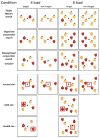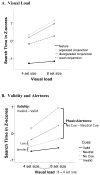Visual search and the aging brain: discerning the effects of age-related brain volume shrinkage on alertness, feature binding, and attentional control
- PMID: 23356596
- PMCID: PMC3718286
- DOI: 10.1037/a0030921
Visual search and the aging brain: discerning the effects of age-related brain volume shrinkage on alertness, feature binding, and attentional control
Abstract
Objective: Decline in visuospatial abilities with advancing age has been attributed to a demise of bottom-up and top-down functions involving sensory processing, selective attention, and executive control. These functions may be differentially affected by age-related volume shrinkage of subcortical and cortical nodes subserving the dorsal and ventral processing streams and the corpus callosum mediating interhemispheric information exchange.
Method: Fifty-five healthy adults (25-84 years) underwent structural MRI and performed a visual search task to test perceptual and attentional demands by combining feature-conjunction searches with "gestalt" grouping and attentional cueing paradigms.
Results: Poorer conjunction, but not feature, search performance was related to older age and volume shrinkage of nodes in the dorsolateral processing stream. When displays allowed perceptual grouping through distractor homogeneity, poorer conjunction-search performance correlated with smaller ventrolateral prefrontal cortical and callosal volumes. An alerting cue attenuated age effects on conjunction search, and the alertness benefit was associated with thalamic, callosal, and temporal cortex volumes.
Conclusion: Our results indicate that older adults can capitalize on early parallel stages of visual information processing, whereas age-related limitations arise at later serial processing stages requiring self-guided selective attention and executive control. These limitations are explained in part by age-related brain volume shrinkage and can be mitigated by external cues.
Conflict of interest statement
There are no financial or other relationships that could be interpreted as a conflict of interest affecting this manuscript.
Figures




References
-
- American Psychiatric Association. Diagnostic and Statistical Manual of Mental Disorders. 4. Washington, DC: American Psychiatric Association; 2001. text revision.
-
- Bach M. The “Freiburg Visual Acuity Test” – Automatic measurement of visual acuity. Optometry and Vision Science. 1996;73:49–53. - PubMed
-
- Benedetti B, Charil A, Rovaris M, Judica E, Valsasina P, Sormani MP, Filippi M. Influence of aging on brain gray and white matter changes assessed by conventional, MT, and DT MRI. Neurology. 2006;66:535–539. - PubMed
-
- Benjamini Y, Drai D, Elmer G, Kafkafi N, Golani I. Controlling the false discovery rate in behavior genetics research. Behavioural Brain Research. 2001;125:279–284. - PubMed
Publication types
MeSH terms
Grants and funding
- U24 AA021697/AA/NIAAA NIH HHS/United States
- AA017168/AA/NIAAA NIH HHS/United States
- R01 AA012388/AA/NIAAA NIH HHS/United States
- AG017919/AG/NIA NIH HHS/United States
- K05 AA017168/AA/NIAAA NIH HHS/United States
- AA010723/AA/NIAAA NIH HHS/United States
- R01 AG017919/AG/NIA NIH HHS/United States
- R37 AA010723/AA/NIAAA NIH HHS/United States
- R01 AA018022/AA/NIAAA NIH HHS/United States
- AA018022/AA/NIAAA NIH HHS/United States
- R01 EB008381/EB/NIBIB NIH HHS/United States
- EB008381/EB/NIBIB NIH HHS/United States
- R01 AA010723/AA/NIAAA NIH HHS/United States
LinkOut - more resources
Full Text Sources
Other Literature Sources
Medical

